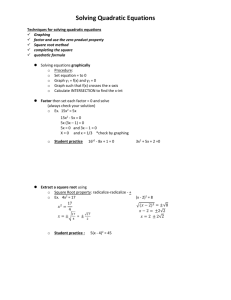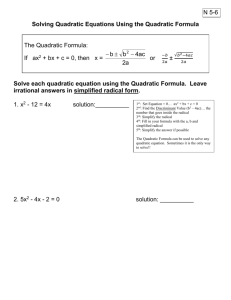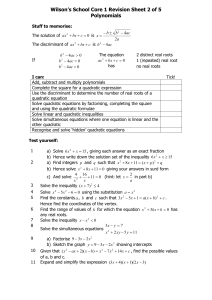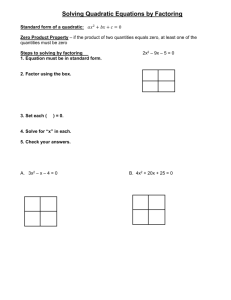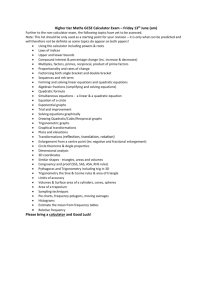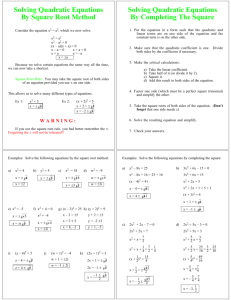1-6 Solving Compound and Absolute Value Inequalities
advertisement
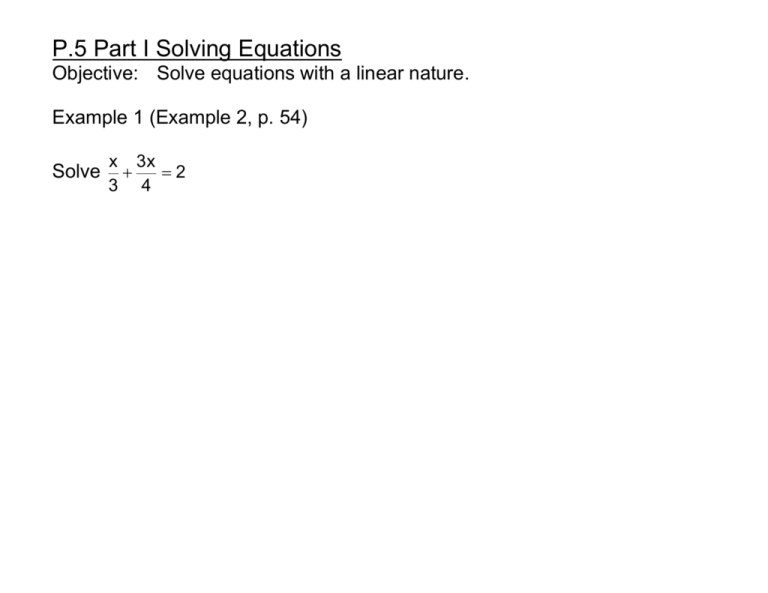
P.5 Part I Solving Equations
Objective: Solve equations with a linear nature.
Example 1 (Example 2, p. 54)
Solve
x 3x
2
3 4
Example 2 (#30, p. 62)
Solve
1
3
4
2
x2 x3 x x6
Example 3 (#36, p. 62)
Solve (x + 1)2 + 2(x – 2) = (x + 1)(x – 2)
Text p. 62 #15-37 odd
P.5 Part II Solving Equations
Objective: Solve quadratic equations.
Quadratic Equation – an equation in the form ax2 + bx + c = 0, a ≠ 1
Four methods for solving quadratic equations:
Factoring
Root Extraction
Completing the Square
Quadratic Formula
Factoring
1. Write equation in standard form with one side of the equation = 0
2. Factor the quadratic expression
3. Let each factor equal 0, and solve each equation.
Example 1
Solve 2x2 – 3x – 2 = 7
2x2 – 3x – 9 = 0
(2x + 3)(x – 3) = 0
2x + 3 = 0
x–3=0
x=
3
2
x=3
Set one side equal to zero
Factor the quadratic expression
Set each factor equal to zero
Root Extraction
To perform root extraction, b = 0, and the equation must be in standard form
ax2 + c = 0
Example 2 (Similar to example 5a, p. 56)
4x2 – 12 = 0
Notice that the “x” term is absent, meaning b = 0
+ 12 + 12
Move constant to other side
4x2 = 12
4
4
Divide both sides by 4 to isolate the “x2”
x2 = 3
x= 3
Extract the square roots
In the case that we must take the square root of a negative number, the
solutions to the equation will be imaginary.
Completing the square
To complete the square, we try to rewrite an equation so that one side of the
equation is a perfect square trinomial. While this method can be done when
“a” is any value, it is recommended that a = 1 when using this method.
Example 3 (#68, p. 63)
Solve x2 + 8x + 14 = 0
- 14 -14
Remove constant term from left side.
x2 + 8x + ____ = -14 + ____
Take half of b and square the result.
2
2
b
8
16
2
2
Place this in each of the blanks.
x2 + 8x + 16 = -14 + 16
(x + 4)(x + 4) = 2
(x + 4)2 = 2
Perform root extraction on both sides
x+4= 2
-4 -4
x = -4 2
If it is necessary to take the square root of a negative number, the solutions
will be complex
Quadratic Formula
To solve an equation in the form ax2 + bx + c = 0, use the formula
b b2 4ac
x
2a
This formula appears on p. 57 of the text. It may be used for any quadratic
equation.
Example 4
Solve 2x2 – 3x – 9 = -1
+1 + 1
2x2 – 3x – 8 = 0
Employ the quadratic formula:
x
x
x
x
b b2 4ac
2a
( 3) ( 3)2 4(2)( 8)
2(2)
3 9 64
4
3 73
4
x = 2.886 or x = -1.386
Set one side equal to zero
Write the quadratic formula
Make substitution
Four types of solutions natures:
If the discriminant (b2 – 4ac) is a positive perfect square, then there are two
rational solutions.
If the discriminant (b2 – 4ac) is a positive number but not a perfect square,
then there are two irrational solutions.
If the discriminant (b2 – 4ac) is zero, there is one rational solution, which is a
double root.
If the discriminant (b2 – 4ac) is negative, there are two complex solutions.
Text p. 63 #43-81 odd
P.5 Part III Solving Equations
Objective: Solve radical and absolute value equations.
With these two types of equations, a key component of solving them is to
take steps to isolate the special type of expression on one side of the
equation.
Example 1 (Example 11, p. 59)
2x 7 x 2
Isolate radical expression on one side.
+x +x
2x 7 x 2
2
2
Square both sides
2x 7 x 2
2x + 7 = (x+2)(x+2)
2x + 7 = x2 + 4x + 4
0 = x2 + 2x – 3
Solve as a quadratic
0 = (x + 3)(x – 1)
Factor to solve
x + 3 = 0x – 1 = 0
x = -3
x=1
Go back and check for extraneous solutions.
2(3) 7 (3) 2
2(1) 7 (1) 2
1 3 2
9 1 2
-3 is not a solution
1 is a solution
Therefore, { 1 } is the solution set.
Example 2
x 1 x 10 1
When there are two radical expressions in the equation, isolate one of them
first.
x 1 x 10 1
Now square both sides of the equation, remembering that the one side is in
binomial form.
( x 1)2 ( x 10 1)2
x 1 x 10 1 x 10 1 x 10 1
Notice the use of the “FOIL” method
x 1 x 9 2 x 10
Combine like terms
-x +9 -x + 9
Isolate the remaining radical
8 2 x 10
2
2
4 = x 10
(4)2 = ( x 10 )2
Square both sides again
16 = x – 10
26 = x
Check solution
Substitute
(26) 1 26 10 1
25 16 1
Evaluate both sides
5-4=1
Therefore {26} is the solution set.
Absolute Value Equations
Solve |2x – 7| + 3 = 16
- 3 -3
First, isolate the absolute value expression
|2x – 7| = 13
Once the absolute value expression is isolated, split the equation into two
parts to remove the absolute value.
2x – 7 = 13
or
2x – 7 = -13
+ 7 +7
+7 +7
2x = 20
or
2x = -6
x = 10
or
x = -3
The solution set is {-3, 10}
If the absolute value expression is equal to zero, there will only be one
equation and only one solution.
If the absolute value expression is equal to a number less that zero, there will
be no solution.
Text p. 64, #95-104 (skip 102), 115-118
